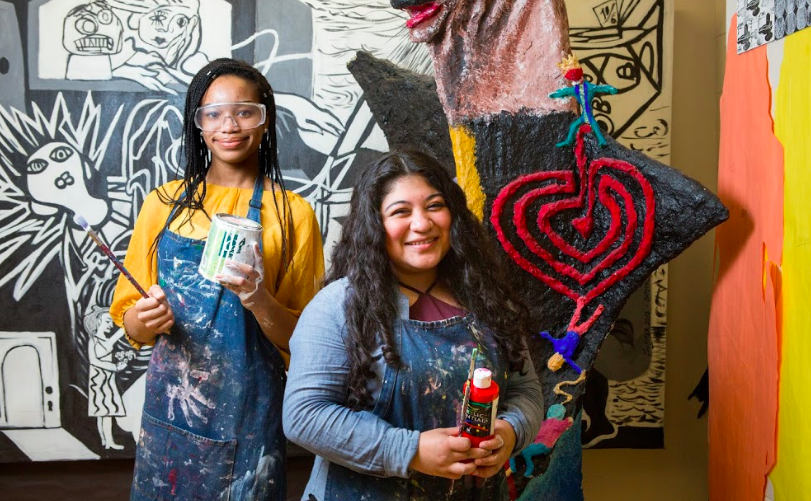How Does Project Based Learning in Elementary Schools Affect Art Eachers

Many teachers integrate art in Project Based Learning when developing public products. While using fine art in this manner tin enrich aesthetic appeal and build pattern skills, infusing art throughout the projection process can enhance every blueprint chemical element of Gold Standard PBL.
Sustained Research
Creating art is more personal expression; it is a mode of investigating, evaluating, and representing the earth. Equally such, art can support inquiry throughout the project procedure. By making sketches, oral histories, videos, and photographs, students can develop their analytical skills every bit they explore a project's driving question. In the case below, pupil Ellie Crowley mixed polaroids and questions to back up her research during Border-land, a project focused on immigration.
Educatee Voice and Choice
Presenting students with a range of artistic options increases pupil choice. Some students may be more than comfortable investigating a topic by sketching it while others may adopt writing verse or making photographs. When approaching art in this style, more students may feel that fine art is accessible to them while simultaneously generating engagement in a topic due to increased individual choice.
For instance, in the Oil-land project, students investigated the topic of energy policy through unlike mediums. This excerpt from the Oil-country paper shows a written piece by Bailey Nicholson next to a motion picture made by her classmate Jonelle Gonzalez.
Authenticity
By elevating art to a cardinal PBL exercise, teachers can implement new strategies that reflect real-world learning. In the real world, professionals do more than than just take notes on what interests them. They create pictures, videos, sketches, essays, models, and more. They record conversations with experts too as collect and archive objects. Adults create art to process and sympathize the things they observe interesting; students should be immune to exercise the same. Pupil Claire Wilson explored free energy policy through a variety of forms, including the embroidered works below.
Reflection
When students utilize art as a tool for research, they can build a rich multimodal annal of their learning. This archive can serve every bit a powerful resource to bulldoze reflection. Past curating their fine art in an evolving portfolio, students have a tangible foundation from which they tin reflect upon their growth. Students tin can pass effectually collective journals like this i from the Edge-state project in order to engage in artistic processes by sharing ideas and posing new questions with their peers.
Public Product
Art is often used in PBL when making public products. However, teachers can consider incorporating art in public exhibitions to highlight not just what students learned but how they learned. Activities like chalk talks, notecard conversations, crude drafts of work, and written reflections can all be exhibited on a gallery wall alongside students' terminal products. Through this approach, the learning process itself tin be viewed equally art.
At a public exhibition of the Edge-land project, visitors observed artifacts of pupil learning, including viewing notecard conversations and listening to recorded group dialogues.
Critique & Revision
Utilizing art practices throughout a project tin can help encourage a spirit of critique and revision. If students view art as an essential part of the learning process instead of just an aspect of a final product, they are more than likely to seek feedback throughout a project instead of nervously fearing critique. Below, students are discussing project driving questions and giving one another feedback during the Oil-country project.
Challenging Problem or Question / Primal Knowledge and Understanding
Rote curriculum tin exist painfully boring. It'southward difficult for teachers and students to get excited nearly pursuing a predetermined path to a predetermined answer. Merely information technology's invigorating for a classroom to learn together, pursuing and posing accurate and circuitous questions similar "What is the purpose of a border?" or "What is the best way to improve energy policy?" Fine art and PBL both ask challenging questions about the earth, and by grappling with such questions, teachers and students can build essential 21st century success skills like critical thinking, inventiveness, and collaboration.
Similarly, art and PBL shift students and teachers from a black and white, right or incorrect mentality—a way of thinking often encouraged in high-stakes testing environments simply which contradicts the complex thinking needed past today's global leaders. In contrast to binary, black and white thinking, the fusion of art and PBL invites students into spaces of nuanced greyness and then they may explore the ambiguity and multiple perspectives inherent in pressing global bug. In this style, infusing art into PBL creates a rich framework to develop the complex thinking and creative problem solving required of nowadays and future global citizens.
Art practices tin can enhance PBL by providing students new avenues to engage with important and challenging questions in critical and creative ways.
Ryan Sprott is a high school humanities instructor in San Antonio, a member of the BIE National Faculty, and the co-founder of Frontier Collective, a long-term art and instruction initiative.
Desire to learn more about PBL? Check out our books.
Source: https://www.pblworks.org/blog/reimagining-art-pbl
0 Response to "How Does Project Based Learning in Elementary Schools Affect Art Eachers"
Post a Comment